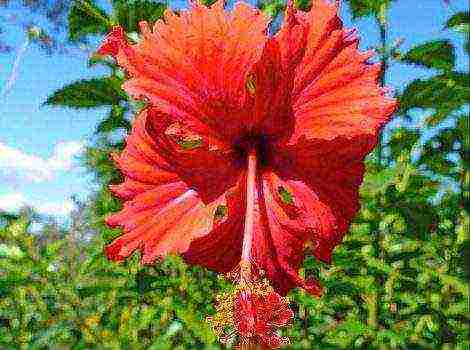Content [show]
Erica is an evergreen shrub of the Heather family, native to South Africa. Some of the nearly 800 currently known species grow in the Mediterranean.
Description and photo
Erica looks very much like heather, but much more spectacular. A bush with straight branches reaches 200 cm in height, there are species - trees, several meters high. The leaves of the plant are needles, up to 1 cm long.

Bell flowers are small, collected in cluster inflorescences. The color is predominantly white, pink, red, purple.
Popular in the Moscow region species and varieties
Erica herbal (ruddy). A dwarf evergreen shrub that forms a lush cushion of delicate greenery. Reaches 20 - 40 cm in height, up to half a meter in width. The shoots are tough, the needles are small, and when the weather gets cold they acquire a bronze color. Abundant flowering occurs in April - May. The flowers are small, arranged in a one-sided raceme, pink, red or white. Blooming Erica exudes a pleasant honey scent. It grows very slowly. Winter hardy. Varieties:
- Aurea - a variety with yellow-colored foliage and pale pink flowers;
- Challenger - with bright crimson flowers;
- Gold star - the foliage has a golden hue, the flowers are white;
- Isabel - snow-white bloom;
- Rosalie - pink flowers;
- Rubra - pink inflorescences with lilac tint;
- The Snow Queen is a variety with white flowers;
- Winter beauty - flowers of a rich pink hue;
- Winter ruby - the flowers are bright red.
Erica is graceful. Bush, half a meter high, pyramidal in shape. Leaves are linear, up to 4 mm, light green. The flowers are bright red, appear on the plant in October and bloom all winter. This variety is grown as a houseplant.
Erica cruciferous (four-dimensional). Lush shrub with a height of 40 - 50 cm. Needle foliage, gray-green color. Blooms in mid - late summer with red or pink flowers. Varieties:
- Ardi - flowers are dark pink with a lilac tint;
- Pink shine - pink-purple flowers;
- Silver bell - white flowers with a silvery sheen;
- Pink star - pink bloom.
Erica darlenskaya. Evergreen, spreading shrub up to 50 cm high. It grows quickly and is distinguished by abundant flowering of pink or purple flowers. Varieties:
- Flattened silver - a variety with dark green foliage and white flowers;
- Darley Dale - profuse lilac-pink bloom;
- The setting is purple flowers with a pink tint.
Erica is pink. Winter-hardy species, reaching a height of 50 cm. Grows quickly, blooms pink.
Reproduction
Erica can be propagated by seeds and cuttings. Hybrid varieties are propagated by cuttings that do not transmit their qualities through seeds. Cuttings are cut from the mother bush in late summer (August). The twigs are rooted in pots or plastic bottles in a sandy-peat mixture. A bag is put on the pots to maintain high humidity. The plantings are regularly aired, watered and sprayed. For the winter, the plants are brought into the room.They are planted in the ground in the spring, with the onset of warm weather.

Erica seeds are grown through seedlings. The seeds are spread over the surface of a moistened substrate consisting of peat and sand. Seedlings will appear within a month. Seedling care consists in providing a temperature of +16 degrees, careful watering through the pan. When the seedlings grow to a height of 10 cm, they are dived into separate pots. Plants are planted in open ground the next year.
Site selection and soil preparation
Erica is a light-loving shrub that does not tolerate direct sunlight. When grown at home, it is placed on the eastern window sills. In the garden, slopes facing east or west are suitable. You can plant shrubs under trees so that their crown shades planting at noon.
Erica's branches are fragile, so the plant is planted in places protected from the wind.
The shrub grows in well-drained, nutrient-rich soil. The stagnation of moisture at the roots is destructive. A good substrate composition should include turf, humus, sand and peat. The acidity of the soil is different for different species. For example, Erica Darlinska grows only in acidic soil, and ruddy soil needs neutral.
In the garden, the shrub is planted only in spring, when the soil warmed up to at least +10 degrees. In the middle lane and the Moscow region, the plant is planted in May. Autumn planting is possible only in southern regions with warm winters, and even then there is a risk that the plant will not have time to take root.
Landing
Planting holes are prepared with a depth of 20 - 25 cm. Sand is poured at the bottom, in a layer of 2 - 3 cm. If the soil is clayey and wet, the drainage layer is increased, and crushed stone or expanded clay is added to the sand. Next, the hole is filled with fertile soil mixed with peat and sand. The distance between Erica bushes is 40 - 60 cm.
The seedling, 2 - 3 hours before planting, is kept in water, with the addition of a root formation stimulant (Kornevin, Heteroauxin). After that, it is placed in a hole and covered with earth, having previously straightened the roots and watered abundantly.
Care
Watering Erica is carried out regularly, with soft water, strictly at the root. For varieties - lovers of acidic soils, once a week, the water can be acidified with citric acid or vinegar. The soil under the bush should not dry out. Mulching the surface of the earth with peat and sand will help to preserve valuable moisture.
The plant reacts positively to spraying with cool water several times a week in the summer. At the same time, you should not get on the flowers and spray in the midst of the heat!
Fertilizers are fed twice a year. In the spring, as soon as the soil has dried up after the snow melts, superphosphate granules (30 g per 1 square meter) are scattered under the bushes. After flowering, they are fed with a complex mineral fertilizer for rhododendrons and azaleas (Kemira, Agricola). You cannot use fresh organic matter!

It is important to properly prune the shrub. In the spring, they clean the bushes, removing broken, frozen and weak branches. After flowering, shoots with faded buds are shortened. Cuts of branches are coated with garden pitch or a mixture of clay with a mullein.
In the open field, Erica needs to be covered for the winter. As soon as the first cold weather begins, and a slight frost bites the soil, the shrub is mulched with peat or fallen leaves. Cover with spruce branches or agrotex from above. At home, wintering takes place in a cool (+ 14 ... + 16 degrees) and bright room, with moderate watering.
Erica can be annoyed by ticks and worms. You can get rid of parasites by wiping the bush with an alcohol solution, soapy water or spraying with an insecticide.
The Erica plant is a beautiful evergreen herbaceous or tree-like shrub of the heather family with narrow, bright green needle-shaped leaves and small bell-shaped flowers.
The color of the flowers ranges from white and pink to red and purple. The flowering is so abundant that no leaves are visible.Thanks to her unpretentiousness and attractiveness, Erica is loved by gardeners.
Grow it outdoors and in pots... Erica reproduces vegetatively and by seeds.
Saplings are planted on the site immediately, and Erica is grown from seeds in room conditions, and only a year later they are planted in open ground.
Common varieties of the Erica plant
- Ruddy (herbal) Is a shrub up to 60 cm tall, blooms from April. The color of the flowers is pink, reddish, rarely white.
- Darlenskaya is a hybrid of erika ruddy, plant height - up to 50 cm. It is distinguished by its good winter hardiness and a long flowering period. The flower color ranges from white and lilac-pink to purple-pink and purple.
- Graceful - it is bred more often as a pot culture. It blooms with reddish, snow-white and pink flowers for several months, starting in November.
- Pink - reaches a height of 20 cm, blooms from April with red flowers.
All these types of erica are propagated by cuttings or seeds.
Planting a flower on the site
Erica is planted in a permanent place in the spring before or after flowering... The place is chosen sheltered from drafts, well lit. Without direct sun, the color of leaves and flowers fades.
Erica prefers light, breathable, acidic soil. Therefore, peat and sand are introduced into the soil.
Eric's stagnant water can't stand, it should be planted in places where there will be no heaps of melted snow in spring. When planting potted crops, you need good drainage.
Plants are planted at a distance of 50 cm, keeping a planting density of 5-6 bushes per 1 sq. M. Planting depth - 20-25 cm, the root collar is not buried. For good rooting and growth, the first couple of months, the plants are watered in a day or two.
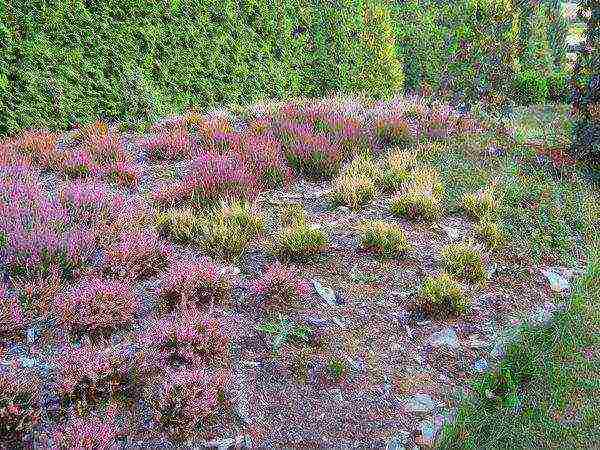 Erica bushes are planted at a distance of about 50 cm from each other
Erica bushes are planted at a distance of about 50 cm from each other
Care
Plant roots are shallow, therefore loosen the soil superficially, to a depth of 6 cm.
You can mulch the soil with peat, pine needles, sawdust or bark with a layer of 5 cm. Mulch acidifies the soil, prevents weeds from growing, conserves moisture and ensures a safe winter.
Top dressing
Fertilize Erica when planting bushes, before flowering, and also after pruning. Fertilizers are scattered under bushes or added to the water when watering. They are fed with complex mineral fertilizers such as kemira-universal (20-30 g per 1 sq.m.), fertilizers for rhododendrons or azaleas, but in lower dosages.
Erika should not be fertilized with fresh organic matter.
Watering
Although Erica is drought tolerant crop, drying out of the soil must not be allowed. Watered with warm soft water and sprayed over time.
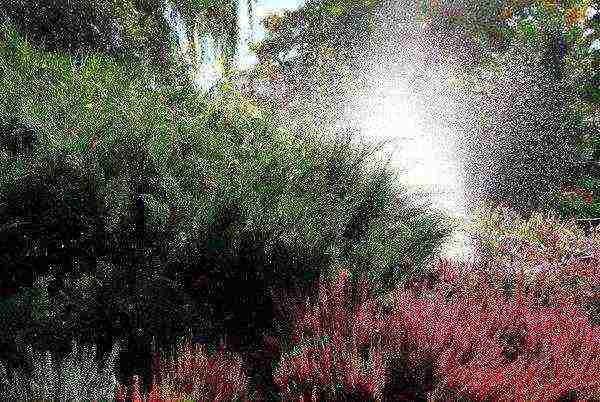 Do not allow the soil on which Erica grows to dry out
Do not allow the soil on which Erica grows to dry out
Pruning
Pruning bushes provides rich flowering and improves bushiness... Lignified branches do not form new shoots, therefore, after flowering, the part where the leaves grow is cut off.
The pruning is carried out asymmetrical - it gives the bushes a more attractive natural look.
Wintering
The trunk circles of the bushes are covered with a layer up to 10 cm dry foliage or peat. Plants are covered with spruce branches: it protects from cold weather, prevents condensation and acidifies the soil with needles.
Reproduction
By cuttings
With apical cuttings, Erica is propagated before flowering or a month after it.
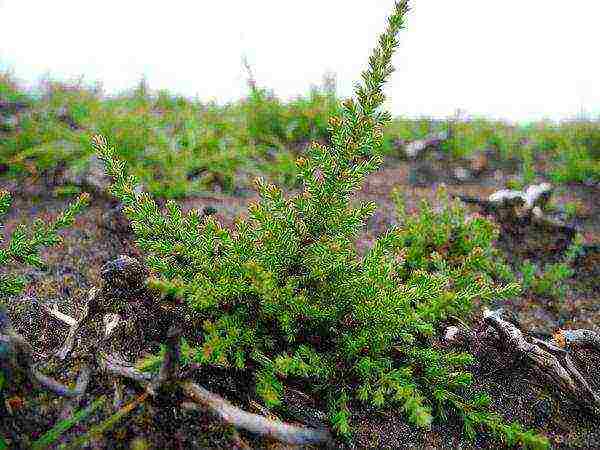 Erica cuttings are planted in the ground after rooting
Erica cuttings are planted in the ground after rooting
Cuttings are cut 2-3 cm long and planted in an earthen mixture of 2 parts of peat and 1 part of sand, deepening 1/3 of the length into the ground. Sprinkle the soil on top with sand with a layer of 1 cm.
Pots with cuttings are covered with polyethylene or glass, kept at a temperature 18-20 degreesshading from the sun. Fertilize regularly with micronutrient fertilizers and a weak urea solution. After 3-4 weeks, the seedlings should take root.
Layers
In the spring on the bushes they choose strong shoots, tilted to the loosened soil, attached with a wire or hairpin, covered with earth.
The soil is moistened, preventing drying out.When the shoots take root, they are carefully separated and planted.
Seeds
For sowing seeds, an earthen mixture is prepared from heather, coniferous soil and sand (in a ratio of 2: 1: 1). The seeds are small, they are not covered with earth, but only slightly pressed to the soil. The soil is moistened with a spray bottle, and high humidity is maintained for a week.
The container is covered with glass or polyethylene, the temperature is maintained at 18-20 ° C, and aired daily. Shoots will appear in a month.
 Erica seeds can be harvested on their own after the inflorescences dry
Erica seeds can be harvested on their own after the inflorescences dry
Seed propagation laborious, therefore, it is rarely used and mainly for natural plant varieties.
By dividing the bush
An old adult bush is dug up, divided with a knife or shovel into pieces and planted.
Diseases and pests
Fungal diseases:
- Gray rot - a gray bloom appears on the branches, the plant sheds foliage, twigs partially die off. The reason is high humidity.
- Powdery mildew - young twigs dry up, and the plant is covered with a white-gray bloom.
- Rust - red-brown spots are formed on the leaves.
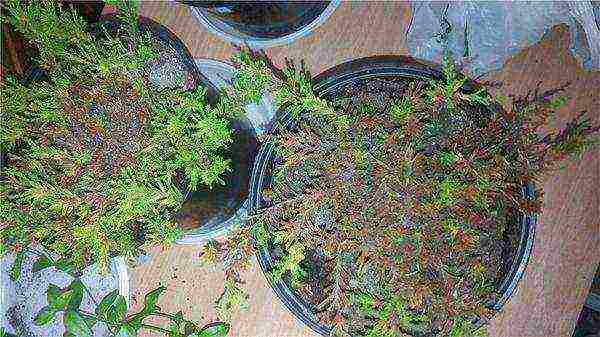 When Erica is damaged by gray rot, the twigs die off
When Erica is damaged by gray rot, the twigs die off
Spraying with antifungal fungicides such as Topaz or Fundazol is recommended, and in severe cases, with Bordeaux liquid or 1% copper sulfate solution. After 5-10 days, the treatment is repeated.
At viral the disease, flowers and shoots are deformed, the color of buds and foliage changes. Unfortunately, there is no cure for this disease; the bushes will have to be dug up and burned.
On defeat scale insects and spider mites on the bushes, a cotton-like bloom and cobweb appear on the underside of the leaves, the foliage is deformed and turns yellow. Treatment with fugincides is recommended, for example, "Fitoverm" or "Aktellik"
Use of landscaping
Erica is used in single and group plantings, as a ground cover plant and as a pot culture for decorating verandas and windows.
Decorative and organic Erica bushes look in company with barberry, heather, cereals, decorative ground covers, Japanese spirea, undersized conifers.
Erica branches are used to form a winter bouquet. The cut branches are dried in a vase. Flowers are sprayed with hairspray to prevent shedding.
Completely easy to care for, but surprisingly ornamental plant will decorate the garden and will delight with a palette of colors for most of the year.
Not every plant can boast a bloom that lasts from fall to Christmas or even spring. Erica can. How to grow this unique plant?
Erica is an evergreen shrub from the Heather family. This plant has very brittle twigs and delicate, small flowers of white, purple or lilac color. Erica is popular in gardens not only because of her attractive appearance. It is unpretentious, so even beginners can easily grow it on their site.
Erica's landing
The best a place for growing Erica - in the sun or in partial shade. The soil should be moderately moist. In dry weather, watering is necessary - especially during the active growth of shoots. Otherwise, they will grow short, and there will be few buds.
Erica even puts up with heavy clay soils that contain calcium
A plant with a closed root system can be planted in a permanent place at any time of the year. The diameter of the planting holes should be 1.5-2 times larger than the diameter of the pot. At the bottom you should put peat or sand (depending on the mechanical composition of the soil on the site), some mineral fertilizers. Mix everything thoroughly and plant the plant 2 cm deeper than in a pot. The plant must be watered abundantly and, when the water is absorbed, mulched.
Erica's care
Plant care is minimal. All Erica needs is timely feeding and weeding, as well as mulching.
Feed the plant follows 2-3 times per season. In the spring - with ammonium nitrate or urea, and in the summer (in June and early July) - with complex chlorine-free mineral fertilizers. Potassium chloride is extremely disliked by all heathers. From potash fertilizers, it is better to use potassium sulfate.
Erika needs very little phosphorus: when planting, they add a little superphosphate, after a while - complex fertilizers (5-7 g / m2).
Mulching helps to retain moisture in the soil, inhibits weed growth and performs well as a decorative function. Chips, bark or sawdust can be used as mulch.
Erica bloom
Erica blooms for a very long time. The buds are colored in late September - early October and so they leave before winter. In a snowless winter, Erica is able to delight with beauty for a very long time until the snow falls. And in the spring, as soon as he leaves, Erica is again among the first beauties!
Erica flowers continue to develop and their beauty reaches its peak in April-May. Moreover, even closed buds help to create it - they are bright and do not lose their charm.
Erica is famous for its long flowering
Reproduction of Erica
Erika can be propagated summer cuttings escapes, but the easiest is - dividing the bush in autumn or early spring.
The height of different varieties usually does not exceed 25 cm. Erica grows in breadth, the lower branches lie on the soil and take root after a while. Bushes can form rather large sods with small dense "cushion mats"
1-2 years after planting the bush, it can be carefully dug up, divided into several parts and planted. The roots are very small, fibrous, so they cannot be kept in the air for a long time. If Eric is raised for several years without dividing, large blooming clumps will turn out. However, it is advisable to plant the plant after 3-5 years, otherwise "bald spots" will appear.
To get a more compact bush, after flowering in late spring - early summer, the tips of the shoots need to be trimmed a little. This will stimulate branching: more young shoots will appear, and, accordingly, flowers.
Company for Erica
It may seem that Erica looks very modest - a kind of fluffy lilac "rug". To heighten the effect, you can "add" ground cover to it. Plants with bright green, yellow or variegated foliage (stonecrops, rejuvenated, saxifrage, conifers, etc.) are especially good in this regard.
Erica looks very beautiful in rocky gardens, in groups with conifers, various shrubs, as well as in combination with snowdrops and crocuses. Florists are happy to include this plant in winter and Christmas compositions.
If you like this gentle and "long-lasting" plant, also plant a related heather in the flower garden. And how to care for him, read our article.
From the very beginning of spring to late autumn, the amazing plant Erica, belonging to the heather family, pleases with its exuberant long flowering, a variety of color palette. Originally from South Africa, it has thoroughly won the hearts of gardeners around the world.
Description
Most erica species are evergreen shrubs that are very similar to heather. It is distinguished by narrow needle-like leaves up to 1 cm long, similar to needles, which grow at right angles to the shoot. During the flowering period, Erica is covered with numerous small flowers, reminiscent of elongated drooping bells. They are collected in large one-sided brushes and come in a wide variety of shades - from white to deep purple. After flowering, the color remains for a long time. The fruits are capsules with very small seeds that remain viable for several years.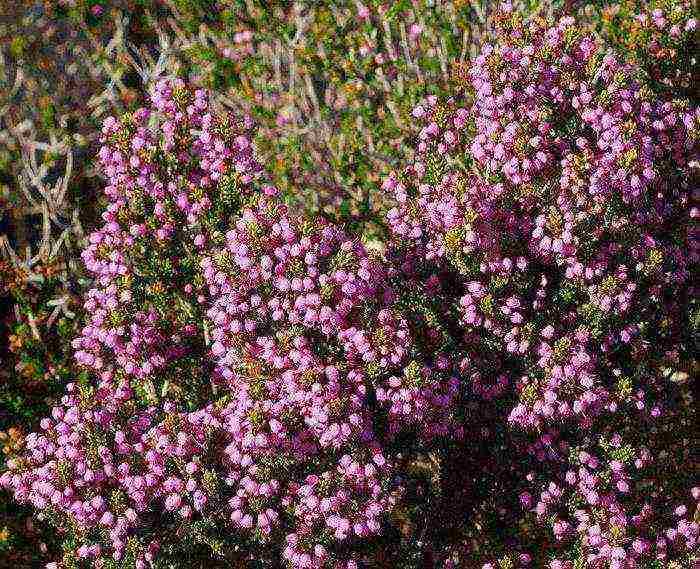
In the role of a cultivated plant, natural erica species began to be used in England from the middle of the 18th century.Then, already in Belgium and Holland, almost a hundred years later, breeding work began, thanks to which many hybrids appeared. Today, the Erica plant, some of whose species are described below, is grown both outdoors and in pots, decorating windowsills and terraces. It is unpretentious and does not need special care.
Types of Erica
This plant is distinguished by a wide variety of species. Among them there are several gardeners that are distinguished by an increased interest in them:
- The very first to bloom is Erika herbaceous, or ruddy - already in April it is covered with pink or reddish bells. The height of this shrub is from 30 to 50 cm. Its outstretched stems are capable, under favorable conditions, of forming a pillow up to half a meter in diameter on the soil surface.
- Erica graceful is cultivated mainly as a pot plant. Flowering begins in November and lasts for several months. There are several varieties of Erika graceful - with white, pink and reddish flowers.
- Erica Darlenskaya plant is a hybrid created by English breeder Darley Dale in the early twentieth century. Today it is widespread in Russia. Differs in high winter hardiness and abundant long flowering. There are more than 20 varieties of this species, the tallest of which reaches a height of 50 cm.
- The Erica rosea plant is one of the smallest species. Its height rarely exceeds 20 cm. Dark red flowers appear in April.
All species of this plant are propagated by seed or cuttings. The seedlings can be transplanted to a permanent place no earlier than after 1.5–2 years.
Seed propagation
This method is quite laborious and is recommended mainly for planting natural types of erica. Seeds are sown on prepared soil, consisting of coniferous, heather earth and sand (in a ratio of 1: 2: 1, respectively) and covered with glass or plastic wrap. In this case, the temperature must be at least 18 ⁰С. Every day the soil with seeds is sprayed with warm water. The seed germination process is quite long and takes at least 1 month. As soon as the shoots appear and grow a little, they dive and gradually accustom them to sunlight. In order to get stronger, the seedlings will need another 2 months.
Propagation by cuttings
Plants grown in this way begin to bloom much earlier than those planted with seeds. Planting material is harvested in the fall, cutting off the tops of lignified shoots. Pre-soaked in a growth stimulator, the cuttings are planted in a substrate consisting of a mixture of peat and sand. Before that, it is recommended to spray them with water. The soil should be sufficiently moist and loose, and the temperature should be 18–20 ⁰С. Planting should be protected from direct sunlight.
After about 3 months, the cuttings take root. Now you can start gradually exposing them to the sun and fresh air. This hardening period lasts for a month. Only then can the young Eric's plant be planted in the garden.
Choosing a landing site
It should be noted that in nature, plants grow only on air-permeable soils. Without good drainage, they simply won't develop fully. The plant does not tolerate stagnant water. When choosing a landing site, avoid areas where there is an accumulation of melted snow. In order for the bright color of the leaves and flowers to remain, Erica needs a sufficient amount of sun. Do not plant it in shaded and windy areas. Erica is a plant, planting and caring for which is not difficult if the place for it is chosen correctly.
Care features
Erica prefers slightly acidic or neutral soil. If you add a little river sand to it, then the plants will feel great for many years.Growing erica is within the power of even a novice gardener. All this plant needs is to ensure timely watering, feeding and pruning the shoots when flowering ends.
Erica is a plant that home care also includes preparing for the winter. Before the onset of the first frosts, it is necessary to moisten and mulch the soil, and cover the plantations with dry foliage or spruce branches. Mulch will not only provide the plant with a good wintering, but also enrich the soil with useful substances.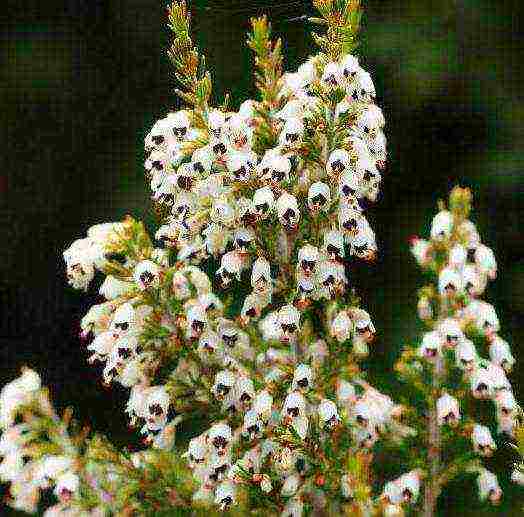
Top dressing
Mineral fertilizers are usually applied during planting, before flowering and after pruning. They are scattered on the surface of the soil, lifting the branches of the plant to prevent them from being burned. Fertilizers can be added to the water used for irrigation. When loosening the soil, a layer of mulch is poured on top (up to 5 cm thick). Pine bark, wood chips and peat are used as it.
Watering
Although the Erica plant is a drought tolerant crop, caring for it necessarily includes regular watering. It is necessary to ensure that the soil is always moist. The water should be soft and of a certain temperature. When the soil dries out, watering is required especially plentiful. The potted plant can be completely submerged in water for half an hour. Eric's plant is very sensitive to air humidity. Therefore, it is recommended to spray the ground part periodically.
Pruning
This procedure, which is mandatory to maintain a decorative appearance, is performed immediately after the flowering of erica. It allows you to form a beautiful and regular bush. In addition, pruning allows for more lush and more abundant flowering in the next season.
Only the green part of the shoot, which has leaves, should be removed. Experts recommend asymmetrical pruning - it allows you to preserve the natural appearance of the plant and give a more attractive appearance.
Diseases and pests
The most common diseases inherent in this plant are caused by fungal and viral infections. Among them, gray rot is most common. The cause of its development is usually high humidity. The first signs of the disease are gray bloom, leaf fall and the death of young shoots. Today there are enough different antifungal insecticides to help cope with gray mold: "Fendazol", "Topaz". For very serious rot injuries, spraying with a 1% solution of copper sulfate is recommended. Treatment of diseased plants is carried out twice with an interval of 5-10 days.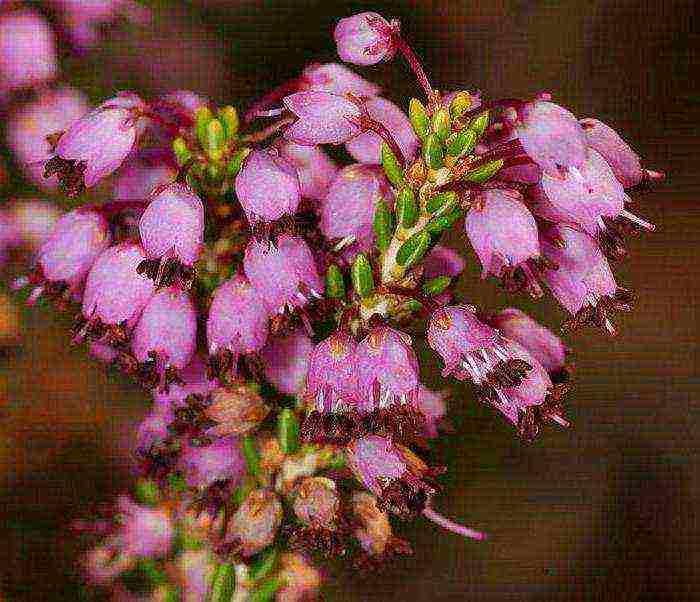
For prophylactic purposes, spraying is carried out in the autumn-spring periods, using the above-mentioned preparations for this.
As for insect pests, their plant is practically not interested in Eric. Occasionally you can find bugs and ticks on it. Treatment of the stems and leaves of the plant with an alcohol solution, which is applied with a brush, is effective against them. Then the areas affected by pests are additionally treated with special agents called "Actellik" and "Fitoverm".
Application in landscape design
Erica, thanks to her late flowering, is a real find for gardeners who create rock gardens, rockeries and flower beds. Landscape designers often use it as a ground cover. In addition, blooming Erica looks great both in mono compositions and in group plantings. 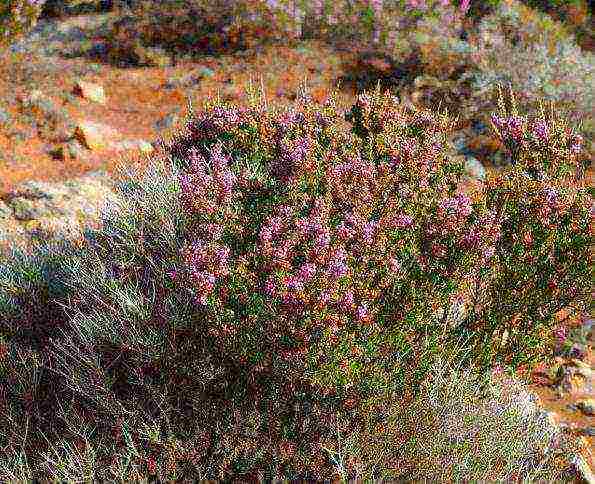 The plant in the garden creates a special microclimate that contributes to the development of other crops - heather, cereals, barberry, Japanese spirea. With such neighbors, Erica looks especially attractive.
The plant in the garden creates a special microclimate that contributes to the development of other crops - heather, cereals, barberry, Japanese spirea. With such neighbors, Erica looks especially attractive.
For many years this plant has been a recognized decoration of the garden.

